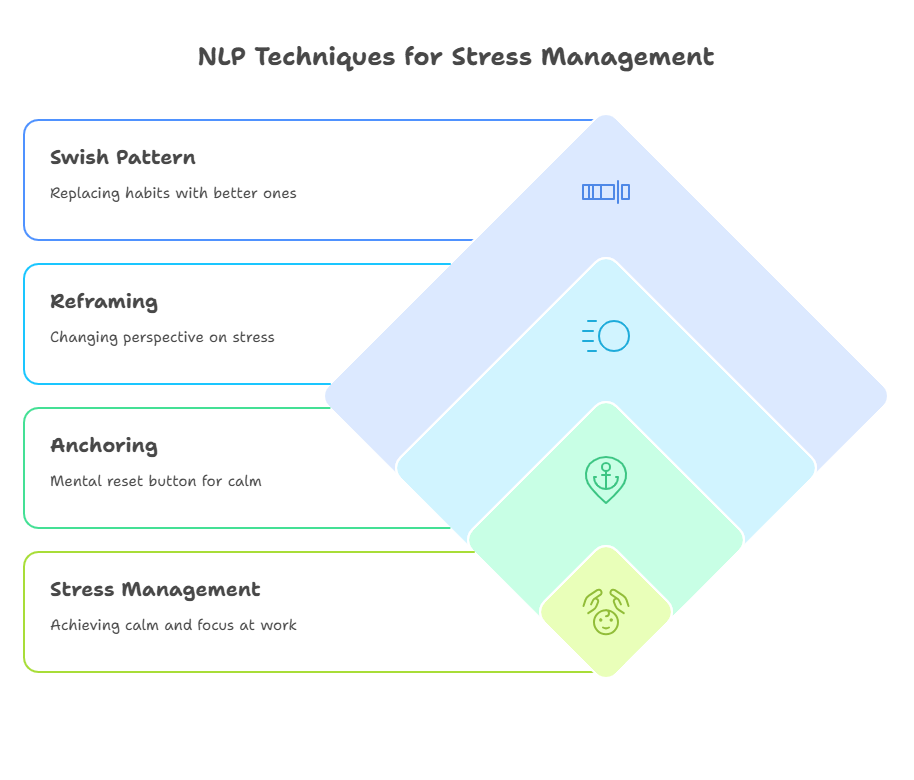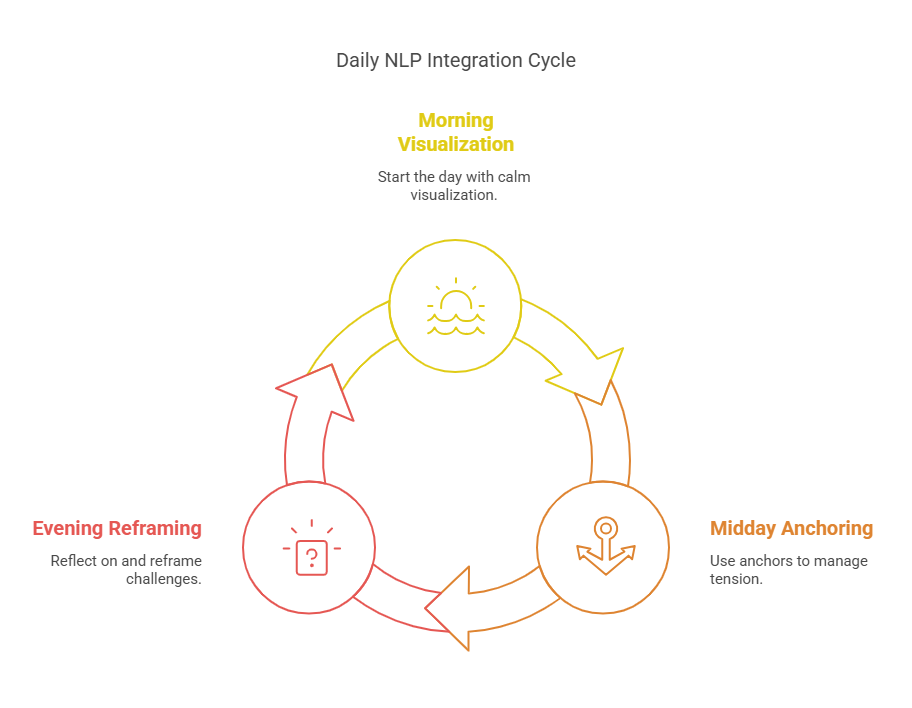Work stress can quickly turn from a minor irritation into a full-blown obstacle. Deadlines, endless emails, and constant multitasking leave you feeling overwhelmed and scattered. But here’s the thing: stress doesn’t have to take control. NLP for stress management in high-pressure workplaces, allowing you to stay calm, focused, and in control even in high-pressure situations.
Whether you’re in a leadership role, tech, healthcare, or finance, work environments demand quick thinking, emotional resilience, and clarity. That’s where NLP comes in. It trains your brain to react to pressure with clarity and composure, rather than panic.
Let’s dive into how NLP works and how you can start using it to manage stress and boost your performance in the workplace.
What Is NLP for Stress Management in High-Pressure Workplaces and Why It Works for Stress

Neuro-Linguistic Programming (NLP) is all about how your brain processes thoughts, emotions, and behaviors and how you can use that understanding to gain control over your reactions. It’s a powerful tool that allows you to shift your mindset quickly, so you can respond to stress with calm and clarity instead of panic or overwhelm.
Think of NLP as a mental reset button. When stress management hits, NLP helps you switch gears transforming anxiety into focus, self-doubt into confidence, and chaos into clear thinking. Unlike meditation, you don’t need to find a quiet space or spend time sitting still. NLP is practical and works in real-time, no matter where you are or what you’re dealing with.
You might wonder, Is NLP therapy? Not exactly. While therapy digs deep into past issues, NLP is more of a mental toolkit quick, actionable, and designed to give you immediate relief. Whether you’re facing a tight deadline, handling a tough conversation, or just feeling overwhelmed, NLP gives you tools you can use on the spot to reset your mind and stay in control.
Powerful NLP Techniques to Manage Stress at Work
Stress doesn’t wait for the weekend. It shows up in tense meetings, last-minute changes, overflowing to-do lists, or even that email that lands at 4:58 p.m. NLP gives you real-time tools that help you reset, focus, and stay grounded without needing to leave your desk.
So read on here are simple, powerful techniques you can start using today.

Anchoring: Your Mental Reset Button
Anchoring is like installing a mental shortcut to calm.
Here’s how it works: Think of a time when you felt calm and in control. Really feel it what you saw, heard, and sensed in that moment. Then, link that state to a physical trigger pressing your thumb and finger together, tapping your wrist, or taking a slow breath.
Later, when stress hits, use that anchor to snap back to that calm state. No one even has to know you’re doing it.
Think of it as your own mental emergency brake quiet, quick, and surprisingly effective.
Reframing: Change the Way You See Stressful Situations
Stress often grows from how we interpret a moment, not the moment itself.
Let’s say your boss hands you a last-minute task. Your first thought might be, Why does this always happen to me? That thought adds fuel to the pressure.
With NLP, you learn to reframe:
Okay, this is tough, but it’s a chance to show what I can do.
That small shift takes the emotional weight off your shoulders and opens up space to think clearly. It’s like switching out a heavy lens for a lighter one everything feels more manageable.
Swish Pattern: Replace Stress Loops with Better Habits
Stressful workdays often trigger unhelpful habits like procrastination, checking your inbox every two minutes, or mentally replaying mistakes.
The Swish Pattern helps you break these loops.
Picture the behavior you want to stop. Now imagine a stronger version of you handling that moment with calm, focus, and confidence. Then, mentally “swish” them fade out the old image fast, and bring in the new one.
Repeat the switch several times. Your brain starts to build a new automatic response, replacing panic with presence. It’s like dragging an old file to the trash and saving a better version in its place.
Visualization: Rehearse Calm Before Stress Hits
If you get nervous before a big meeting, phone call, or presentation, visualization can help you prepare.
Close your eyes. Picture yourself walking into the room calm and focused. Hear your voice steady. Feel your breathing smooth and easy. Imagine it going well start to finish.
You’re giving your brain a roadmap. When the moment arrives, it knows what to do because you’ve already practiced it mentally.
This isn’t wishful thinking. It’s how athletes, surgeons, and performers stay sharp. You can use it too.
Outcome Questions: Shift from Panic to Clarity
When we’re stressed, we tend to obsess over what’s going wrong. NLP flips that by asking better questions. Try this:
- “What do I want to happen here?”
- “What does success look like?”
- “What’s the first step I can take?”
This is called the Outcome Frame, and it gives your brain something useful to focus on. Instead of replaying problems, you start spotting solutions.
It’s like switching from reverse to drive you stop spinning and start moving.
Meta Model: Untangle Stressful Thoughts
Stress often shows up in our self-talk. Like I always mess this up, No one listens to me, and This project is going to fail.
These thoughts feel real, but they’re often built on shaky logic. The Meta Model helps you question them. Ask yourself, like, Always? Every single time? What exactly do I mean by that? and Who says this will fail?
By challenging vague or extreme thinking, you make stress less powerful. Clear thinking means the calmer the action will be.
Perceptual Positions: Get Fresh Perspective Fast
When you’re too close to a problem, everything feels bigger. Perceptual Positions helps you step back. Try this:
- First, imagine the situation from your point of view.
- Then, step into someone else’s shoes your coworker’s or your boss’s.
- Finally, imagine watching it like a movie as a neutral observer.
Then ask:
- What do I see now?
- What’s really going on here?
- What matters most?
This shift in viewpoint helps reduce emotional charge and lets you respond with more balance.
Time Line Technique: Don’t Let One Moment Take Over Your Day
Sometimes a single stressful moment can hijack your whole day. A tense conversation. A mistake. A bad meeting.
The Time Line Technique helps you zoom out. Mentally picture your day as a line. That stressful moment? It’s just a dot. Zoom out to see your week. Your month. That dot gets smaller.
Now ask yourself, will this matter in a week? Often, the answer is no.
That perspective can help your mind let go and move on.
Pattern Interrupt: Snap Out of the Spiral
Caught in a mental spiral? Here’s a quick fix.
Do something unexpected: Clap your hands. Stand up and stretch. Say out loud, Okay, reset. Shake your arms. Tap your chest.
These physical cues interrupt the loop your brain is stuck in. It’s like shaking a snow globe so the flakes settle again. Just one action can bring you back into the moment, fast.
Well-Formed Outcomes: Turn Vague Stress into Clear Action
Big, blurry goals can make stress worse. Instead of fix the project, try this:
- What specifically do I want?
- How will I know I’ve succeeded?
- What’s stopping me?
- What can I do today to move forward?
These questions form what NLP calls a well-formed outcome. The clearer your target, the easier it is to focus, act, and finish strong. Stress hates clarity. Give it none.
Use NLP Daily Without Changing Your Whole Routine

You don’t need to book time off or change your whole life to make NLP work. Try this instead:
- Morning: Do a 2-minute calm visualization before checking your phone.
- Midday: Use your anchor before a meeting or when you feel tension build.
- Evening: Reframe one hard thing that happened. What did it teach you?
Stack it into your day like brushing your teeth. The more you use it, the easier it gets.
Still Wondering If NLP Is for You?
Let’s clear up a few common questions:
Isn’t NLP manipulative?
Nope. It’s about understanding your thoughts so you can make better choices not controlling others.
Does it really work?
Yes if you use it. Like any skill, it works with practice. You don’t need to master everything just one technique can make a difference.
Do I need training?
You can start today with just what you’ve read here. If you want to go deeper later, there are good books and courses but you don’t need them to get started.
Final Thoughts: Small Tools, Big Results
You don’t need another app or a 30-day retreat to manage stress better. You need a few simple tools that work when stress hits in meetings, during deadlines, and before hard conversations. That’s what NLP gives you.
Pick one technique. Try it for a week. See what changes. Because the truth is, you can’t always stop stress from coming but with NLP, you can control how you respond to it. And that can change everything.
Frequently Asked Questions
What Is Nlp, And How Does It Reduce Stress?
NLP, or Neuro-Linguistic Programming, helps reduce stress by changing how you think and respond to challenges. It offers simple tools like anchoring, reframing, and visualization that shift your mental state from panic to focus. Instead of reacting automatically to pressure, you learn how to stay calm, clear-headed, and in control.
Can Nlp Be Used In Corporate Or High-stress Work Environments?
Yes. NLP is especially useful in fast-paced jobs like tech, healthcare, leadership, or finance. You can use NLP techniques during meetings, deadlines, or presentations to stay calm under pressure, improve communication, and make better decisions even in chaotic moments.
How Long Does It Take To See Results From Nlp?
Many people notice a shift after just one or two uses of a simple NLP technique, like anchoring or visualization. Long-term benefits come with regular practice. Like any skill, the more consistently you use it, the more natural and effective it becomes.





